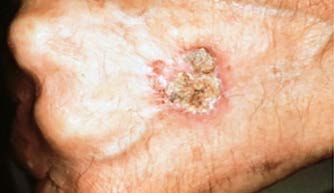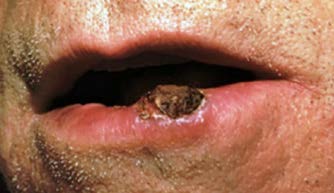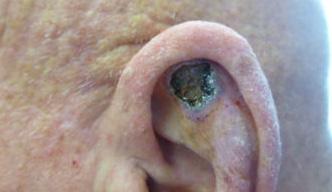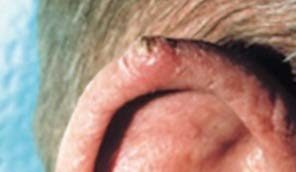
What is Squamous Cell Carcinoma?
![[21682] Squamous Cell V2 Main](/media/2293/21682-squamous-cell-v2-main.png) The second most common skin cancer, Squamous Cell Carcinoma affects 200,000 Americans each year. This type of cancer begins and usually is confined to the epidermis for some time. This type of cancer has a high cure rate but can cause disfiguring, complications or even death if it is neglected and allowed to spread.
The second most common skin cancer, Squamous Cell Carcinoma affects 200,000 Americans each year. This type of cancer begins and usually is confined to the epidermis for some time. This type of cancer has a high cure rate but can cause disfiguring, complications or even death if it is neglected and allowed to spread.
Squamous Cell Carcinoma occurs occurs most frequently on areas of the body frequently exposed to the sun – the face, ears, neck, scalp, shoulders, and back. The rim of the ear and lower lip are especially vulnerable to these cancers. Tumors sometimes develop on areas where the skin has suffered injury: sun damage, burns, scars, sores or sites exposed to x-rays or chemicals.

Who is most affected?
This slow-growing disease affects individuals who have regular exposure to sunlight. Until recently, this cancer was most common in older people, particularly men who worked outdoors. Now, however, more women and younger individuals are being diagnosed with Squamous Cell Carcinoma, especially those who spend leisure time in the sun. People with fair skin; blonde or red hair; or blue, green or gray eyes have higher than average risk. Avoid long exposure to the sun, especially at midday, to prevent Squamous Cell Carcinoma. If outdoors for a long time, consider wearing a hat, sunscreen, long sleeves and a long skirt or pants.
How is it diagnosed?
Your dermatologist or specialist will take a biopsy from the area of the skin with Basal Cell Carcinoma characteristics for the dermatopathologist to examine under a microscope.
How is treatment determinded?
The dermatopathologist consults with your dermatologist or specialist after reviewing the biopsy results. Together, using their combined experience and knowledge, they determine treatment options most appropriate for your condition.
Skin cancer is the most common of all cancers,
yet it is the easiest to cure if diagnosed and treated early.
What should I look for?
The appearance of SCC may differ for everyone affected. In most cases, SCC can be scaly and patchy or look like thickened skin or open sores. These lesions arise on areas of the skin that have been exposed to the sun. Sometimes, they may appear on genitals as well.
 |
A persistent, scaly red patch with irregular borders that sometimes crusts or bleeds |
 |
An elevated growth with a central depression that occasionally bleeds. It may rapidly increase in size |
 |
An open sore that bleeds or crusts and persists for weeks |
 |
A wart-like growth that crusts and occasionally bleeds |

What treatment options are available...
Melanoma can be treated through one or more of the following: surgery, chemotherapy, radiation therapy, as well as new investigative treatments. It’s important to learn as much as you can about the nature of your cancer and your treatment options and to make the decision that’s right for you.
- Common Topical Medications for the treatment of precancerous conditions or superficial Squamous Cell Carcinoma include imiquimod. Using curettage and electrodessication, the physician scrapes off the growth and desiccates the tumor site with an electrocautery needle.
-
Micrography Surgery is another surgical approach during which a physician removes the visible tumor and then removes surrounding skin one layer at a time. Each layer is checked under a microscope for signs of cancer until the physician is sure all the cancer is gone. This technique has a highest cure rate and can save the greatest amount of healthy tissue.
-
Cyrosurgery is a technique that can be performed without any cutting or anesthesia. Liquid nitrogen is applied to the tumor with a cotton-tipped applicator or spray device. The tumor then becomes dry and crusted and falls off.
-
Laser Surgery is often used for cancers on the lip, face or scalp because this treatment provides surgeons with greater control over the depth of skin that is removed.
-
Radiation Therapy uses high-energy, pinpointed x-rays to kill cancer cells. This type of treatment is directed at a specific area. It can be used to treat small tumors, minimizing the damage to normal cells or tissue surrounding the tumor, or can be used to destroy cancer cells that remain after surgery.
-
Photodynamic Therapy is best used on cancers on the face and scalp or if individuals have multiple malignancies. A physician applies a topical treatment that is activated by a strong light. The treatment destroys cancer while sparing surrounding tissue.


